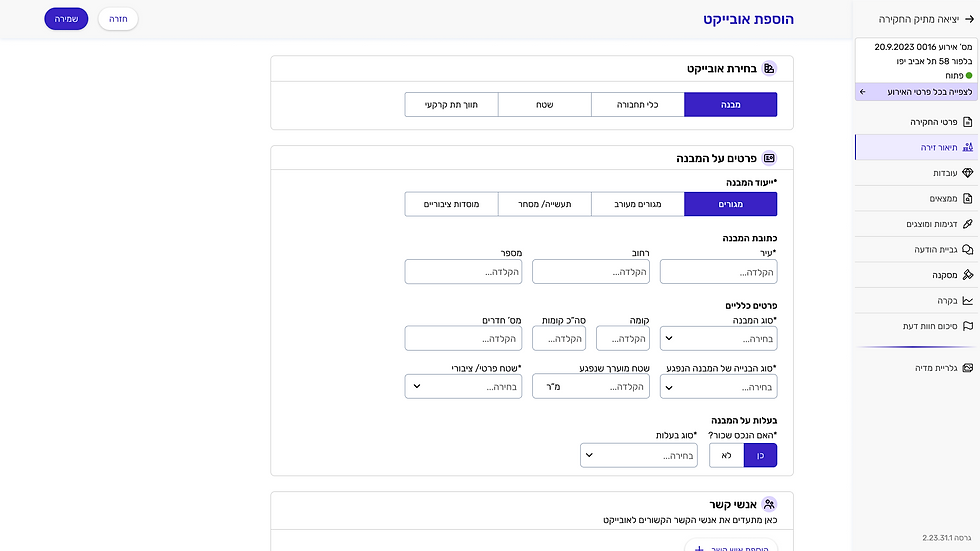
Zik
Fire Scene Module
Overview
Background
The Fire & Rescue Authority operates a nationwide investigation unit responsible for documenting and analyzing fire incidents. Before Zik, investigators used an outdated system called Nitzotz, that relied on free-text reports, resulting in inconsistent data and limited ability to generate insights or statistics.
Problem
The Scene Description section in prior system "Nitzotz" was based
only on free text which create No structured data meant no ability
to generate insights or statistics.

Goal
To design a new Scene Description module within the new system Zik, enabling:
-
Fast and intuitive data entry for investigators.
-
Structured, consistent, and complete reporting.
-
Balance between guided fields and freedom for
professional judgment. -
Exportable and analyzable data for organizational learning
and external collaboration.
Research
Research Methdology
-
Interviews with investigators.
-
Data analysis of investigation records
from Nitzotz.
Insights From Interviews

Lack of guidance for new investigators, leading to the “blank page problem.”

Missing important details in reports.

Inefficiencies in report writing.
Data Analysis
Exported 300 investigation files from Nitzotz, conducted a detailed review of each case, and systematically categorized the information investigators recorded in their scene descriptions to identify recurring patterns.
Insights From Data Analysis

Property/ vehicle owner details.

Incident address.

Building Characteristics- Building type, floor, construction type and more.

Vehicle Details - Vehicle type, model, company, license plate and more.

Time the fire call was received by dispatch.
Co-Creation Workshop
Collaborated with the Head of Investigations & Intelligence and a diverse group of investigators.
Validated findings, discussed solutions, and shaped requirements together.
Information Architecture
Together with the client and through a co-creation workshop with the investigators,
we defined a new structure based on objects
(e.g., building, vehicle, underground infrastructure).
Each object included tailored fields relevant to its type, while a free-text field was preserved to allow narrative storytelling. In this process, I built the information architecture: the investigators contributed their professional expertise, terminology, and investigative mindset, while my team and I brought in technological process understanding and user experience knowledge.

Design
Wireframes & Iterations
Created low-fidelity & high-fidelity wireframes in collaboration with the professional team. Iterated multiple times to refine the balance between structure and flexibility.


Usability Testing
Conducted usability tests with investigators (average age 49, low digital affinity).
This is what i found out-

Positive feedback on structured fields improving completeness and learning value.

Need for quick addition of multiple objects > introduced “Save & Add Another” button.


Desire for additional free-text fields for contextual details.
To balance user flexibility with development efficiency, we integrated a third-party
rich text editor instead of building a custom solution from scratch. By tailoring it to user workflows and feedback, we met their need for detailed input while significantly reducing development time.


The final design
-
Modular Object System: Investigators can add buildings, vehicles, or other scene components, each with context-specific fields.
-
Guided Structure + Free Text: Ensures completeness without limiting professional expertise.
-
Clean and Simple UI: Minimal cognitive load, clear hierarchy, and familiar UX patterns for non-technical users.
-
Exportable Data: Enables monthly, quarterly, and yearly reports, and supports collaborations with external bodies (e.g., car manufacturers, Standards Institute).
Impact
The solution enabled investigators to enter data faster, more clearly, and with greater reliability, while also making it easier for new investigators to onboard. For the organization, it created the ability to generate statistics, identify patterns, and share actionable insights with external stakeholders. For the client, the Head of Investigations, the system delivered full satisfaction along with new capabilities for reporting and collaboration.
Key Learnings
-
Leading a design process end-to-end requires balancing strategy, research, and
user empathy.
-
With non-technical users, simplicity, clarity, and visual calm are crucial.
-
Not all old habits are bad: retaining the familiar free-text field preserved user trust and eased adoption.
-
Co-creation with domain experts ensures both usability and compliance with
legal/organizational requirements.